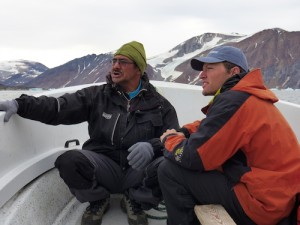Lamont-Doherty Earth Observatory142
-

View from an Iceberg
The science goal for today is to complete 8 CTD casts. We load into our vessel, a Poca 500GR. We have discussed a 6 to 8 hour window of boat time with Gabriel the captain and Magnus our navigator and stocked up on 40 liters of benzene.
-

A Meeting for the Kullorsuaq Community
It seems that many of the local fishermen have gone to hunt Narwal further north but there are several good prospects for boats that Søren will scout further as several of the fishermen are sleeping as the fishing is better right now at night. With 24 hours of daylight day or night fishing doesn’t really…
-

‘Thumbs Up’ for Travel to Kullorsuaq
At the small airport a smiling woman approaches us asking our plans in one word “Kullorsuaq?” We smile and nod and she grins broadly motioning that she and her daughter are going there too – it is their home she manages to convey.
-

The Son of a Hunter
A visit to the Upernavik museum brought us to ‘Edvard’ a young Greenlandic and the local museum curator. Embracing the opportunity to practice his English he enthusiastically spent time sharing the historic art and past of the community and his experiences as a young adult growing up in a Greenland that is shifting from one…
-

The Changing Upernavik Waterfront
Project Background: Changing conditions in Greenland’s northwest glaciers over the last decade have led to a range of questions about water temperature and circulation patterns in the fjords where ocean water meets the glacial fronts.
-

What Geology Has to Say About Global Warming
The most important lessons drawn from geology are that the earth’s climate can change radically, and rapidly. We can’t say precisely at what CO2 level we’re in danger of melting Antarctica, but that threshold could be reached in 150-300 years, if CO2 levels keep rising at the current rate.
-

Glacier Marks on Mount Chirripó
On his sixth day on Mount Chirripo, Lamont’s Max Cunningham finds clues of the mountain’s origins and evolution.
-

Back to Mount Chirripó
On their fifth day of fieldwork on Mount Chirripo, Lamont’s Max Cunningham and Mike Kaplan encounter some deeply weathered boulders.
-
Ancient Ocean Currents May Have Changed Pacing and Intensity of Ice Ages
Slowing of Currents May Have Flipped Switch, Says Study

AGU25, the premier Earth and space science conference, takes place December 15-19, 2025 in New Orleans, Louisiana. This year’s theme—Where Science Connects Us—puts in focus how science depends on connection, from the lab to the field to the ballot box. Once again, Lamont-Doherty Earth Observatory and Columbia Climate School scientists, experts, students, and educators are playing an active role, sharing our research and helping shape the future of our planet. #AGU25 Learn More
